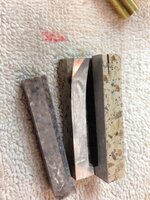I will give you my take on the situation. I looked at the photo and photos serve to tell a story most of the time that the OP does not state.
First off air will not cool a bit. Not sure who started that one. You have 2 materials that will generate alot of heat when drilled. Corian which is basically an acrylic and aluminum that is being drilled LENGTHWISE. Wow that is pushing the envelope. Not saying it can't be done, just will take some finesce. You need to cool the bit some other way. I like to use denatured alcohol after I pull the bit out after some drilling. You can shoot some air to clean the debris. It can not hurt.
The next thing I looked at is where is the glue??? You have to be very careful when glueing pieces together that you do not overclamp and thus starve the joint of glue. This is one reason it is recomended to rough edges and faces abit when gluing. It forms sort of channels for glue to adhere to. When you switched to CA you were basiclly gluing glue to glue(epoxy residue)
I cringe everytime people mention they use coke cans for their inlays. For mere pennies you can get some sheet aluminum from your Home Centers. It is flat and easily sanded to roughen up. With coke or other beverage cans you have films that were applied and if not wiped off or sanded off you have potential for failures. After I sand and just before I start my glueups I wipe the aluminum down with acetone. Works for me.
Finally the point about blowouts on the ends has been mentioned here thousands of times and one simple way around it is to make the blank a bit longer and not drill all the way through but cut the end off. Also if the blank is fragile it has been suggested also to wrap the blank in guaze or wood splints or some other method to give strength to the outside pushing forces when drilling.
Just some of my thoughts. Good luck.

